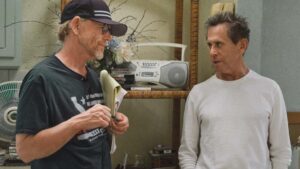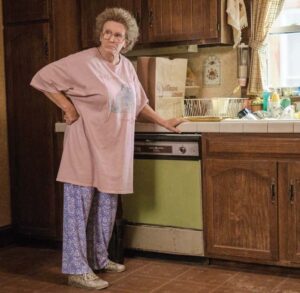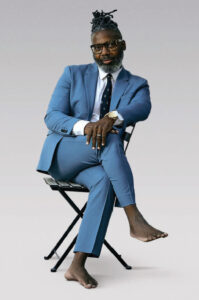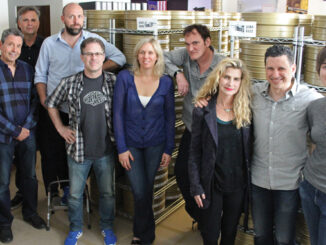
by A.J. Catoline
“I have to pinch myself at times,” said picture editor James D. Wilcox, ACE.
Wilcox has good reason to celebrate his good fortune these days. After starting in TV news and years of honing his craft in commercials, series and comedy specials, he just crowned his body of work by editing director Ron Howard’s “Hillbilly Elegy,” an early Oscar contender released late last year on Netflix.

Starring Amy Adams and Glenn Close, the picture traces the path of a boy struggling to grow up in the rural areas of Kentucky and Ohio guided by his gritty, tough-loving grandmother Mamaw (Close). It’s based on J.D. Vance’s best-selling memoir that became a sensation after the 2016 election.
Wilcox knows a lot about personal journeys. His own started by cutting news, unscripted television, commercials and music videos, before finding a home in comedy on shows like “Reno 911!” and “Everybody Hates Chris.” His big break in drama happened when fellow picture editors Monty DeGraff, ACE, hired him on “Soulfood,” and John Refoua, ACE, recommended him for James Cameron’s “Dark Angel.” He went on to cut the hit dramas “CSI: Miami” and “Roots.” He first worked with Howard and his Imagine Entertainment production company on the pilot of “Genius – Einstein: Chapter One” which he was awarded “Best Edited TV Mini Series or Motion Picture for Television” at the 2018 American Cinema Eddie Awards.
Unlike most successful editors, Wilcox never went to film school or ascended through the ranks as an Assistant Editor. CineMontage recently chatted with him over Zoom to ask about his editing journey.
Q Congratulations on cutting your first feature film. How did you make the transition from being a television editor to a feature film editor?
James D. Wilcox: I never would have drawn a line from being a news editor to a feature film editor. I started in broadcast journalism, working at Clark Atlanta University’s WCLK radio station, and that led to an internship with CNN, and there I got exposed into the world of editing. I spent 9 years at KCBS-TV cutting television news and sports packages. So my storytelling apprenticeship was spent during those years, and it prepared me for being accurate, fast, and creative.
I feel very honored and extremely appreciative of the position that I’m in right now working with Ron Howard and Imagine.
Your cuts are great. I love your performance choices and this is really working.

Q How did you achieve the career dream to get hired to edit a Ron Howard film?
I cannot tell this story of meeting Ron Howard without the connection I first made with Editor Dan Hanley. Ron had always worked with the duo of Dan and Mike Hill. Mike retired after “In The Heart of the Sea,” and I got to know Dan when I was brought in to co-cut “Genius” (Season 1). The plan was to help Dan set the look of the pilot and the series. Dan had just finished cutting “Inferno,” and when he saw all the dailies Ron was shooting for “Genius,” I think he reflected on the convergence of his life and career and he called me up and said, “James, I don’t think I can do the job the way it deserves to be done. I feel like you are the right guy for the project, and I’m handing it off to you.” Dan’s confidence in me allowed him to move into retirement and me to inherit “Genius.” We’ve become really good friends and he’s been a huge mentor figure in my career.
Ron was shooting “Genius” in Prague and I was sending him early cuts. He texted me “your cuts are great. I love your performance choices and this is really working.” I still have that text he sent me. We got along really well in the cutting room.
After “Genius” we did a little pinky swear with Anna Culp from Imagine that we would keep working. I did their show “Filthy Rich” in New Orleans with Director Tate Taylor. Anna mentioned that “Hillbilly Elegy” was being fast tracked at Netflix, and she and my agent pitched me to Imagine Films and Ron for the Editor gig.
I enjoyed reading the script and the book “Hillbilly Elegy” and found a lot of it relatable, aside from J.D.’s politics. I’m from western Pennsylvania, Pittsburgh to be exact. In that region, while it’s not exactly Appalachia, two hours away is Ohio, an hour-and-a-half away is West Virginia, another three hours is Kentucky. So I understand the culture and the people and made sure to mention my roots to Ron during the interview.
I come from a similar background as J.D., a poor but loving working-class family with parents and descendants drawn to the region for its manufacturing blue collar industries. After I graduated high school, I had a summer job in one of Pittsburgh’s steel mills. As J.D.’s Mamaw tells him, “You’ve got to go to school, you’ve got to get good grades just to have a chance.” Those are similar speeches my parents imparted on us. I understood the struggle and perseverance of breaking the cycle of poverty. I understood how addictions damage families. I also understood that to navigate difficult times you must force your will onto your own journey in life.
I think Ron values having a crew that can contribute to the authenticity when making his films. I got a text from him saying “let’s do this.” I saved that text as well.
Q This film feels like it mixes narrative and documentary style as it zig-zags between two timelines showing J.D. Vance as a kid and then later in life at college. How did you approach this editing strategy?
James: The film examines the two most vulnerable periods in J.D. Vance’s life, when he’s at Yale, at age 28, and when he’s 13 years old in Ohio. The goal with young J.D. was to show how precariously close he was to never getting a fighting chance in life. Ron chose to shoot more handheld to reflect J.D.’s instability. Director of Photography Maryse Alberti has documentary experience in her background, and I think she gave the film a certain improvisational edge. Of course it’s all blocked out, but the actors know they have to stay hot at all times because the camera could swing over to them at any moment. That’s where my news background meshed with the cinematic choice.
“Genius” also told a non-linear story, and Ron and I had the benefit of using a lower-third time stamp. I thought we could be more inventive for this film, and Ron and I talked about organic ways to move between the timelines of 1997 and 2011. We accomplished this using news footage, commercials and music cues of the time. The opening sermon informs the audience of the year and the cultures belief system. Cutting between years, it wasn’t necessarily about the time and place but more about the emotional connection between the characters. As J.D. ages, the audience can see the weight of all the challenges he has been carrying his entire life. Ron and I discussed how to make these emotional transitions feel seamless.
We did a lot of visual effects work on the shot of the town’s steel factory. Our production designer, Molly Hughes, went to Pittsburgh and researched old blast furnaces. I told Ron I remembered growing up in Pittsburgh and knew how the smokestacks affected the air quality and exactly how much smoke in the sky would feel authentic. And when it was an abandoned relic, we added birds flying out as another layer of reality.
Q What was it like to cut the amazing performances of Amy Adams and Glenn Close?
Amy Adams (Bev) and Glenn Close (Mamaw) are both incredibly dedicated and deeply intuitive actors who are amongst the smartest actors I’ve ever cut. They definitely put vanity aside in playing two strong-willed, hard-driving, funny women that are unapologetically flawed. They’re both great at improvisation and completely understand where they’re at emotionally at all times in any given scene. Bev’s suicidal breakdown after her dad’s death brought me to tears cutting that scene, as does Mamaw’s begging for extra food from the Meals on Wheels guy gets me every time.

When J.D. Vance saw Glenn Close playing Mamaw, I think he felt like his grandmother was reincarnated, it was a very emotional encounter. Amy’s emotional peek and rhythm is at such a high point, where you cannot easily go across takes, in most instances you have to pick a base take and really ride it through. In the motel scene when J.D. busts in as she’s trying to shoot up heroin, she spirals out of control, yet it was important to make sure the audience has empathy for her and understands the pain she’s carrying around. After friends and family screenings, Ron would ask the audience, “Should we cut her down? Is she too much?” And everybody almost unanimously understood it was a tough emotional watch, but it felt authentic.
Q How did you insert moments of comedy into this dramatic story?
I like finding those moments of levity because “Hillbilly Elegy” gets really heavy at times and you need laughter to counterbalance the weight of the movie. For example, when Bev threatens to kill young J.D., he runs inside this woman’s house as his mother is chasing him. The woman doesn’t know what the hell is going on and she tells Bev to keep out, saying “I have dogs, they bite!” We cut to this shot of two silent Corgis, and that moment is one of the biggest laughs in the movie. This was a great opportunity to pivot from drama to comedy and back to drama. After screenings I adjusted the timing on the cut to the dogs to get a longer laugh. I also took note of every laugh intended or not to help inform the cutting room of how the audience was responding.
Q What was it like working with composer Hans Zimmer on the music?
Hans Zimmer and David Flemming are really great collaborative storytellers. Hans asked me “Who did the temp music?” He said it was “frustratingly good.” We really hit it off after that. We all were culturally sensitive and respectful to the region and wanted to avoid musical stereotypes, especially banjo. “Deliverance” to this day triggers a bad reaction from the Appalachian community. In Papaw’s funeral scene, the score is more of a Celtic/Scottish vibe that speaks to the people who had immigrated to the region. When Bev is in the street with her attempted suicide, we really worked hard to not over-score the scene and opted to mix in sound design. Hans felt the music could be more weird to further highlight Bev’s pain and grief. There was a lot of trial and error with spotting and scoring. Often times we didn’t know what worked until we heard it. And that’s when we knew it was working beautifully.
When we were remote mixing during the pandemic, it was really challenging to not all be on the stage together, but we were all on the same page. Netflix sent us all the same headphones, so we all were listening to it the same way. Hans didn’t need to wear headphones because he was listening to it on the speakers at his home studio.
Q You brought in two new Assistant Editors on this project, Ulysses Guidotti, and Nolan Jennings. How did you work with your assistants?
I couldn’t bring my longtime assistant, Auggie Rexach, to New York because you have to hire local to get the tax incentives. I had known Nolan from a show called “Gone” that we worked on in L.A. together. We got along well and I understood his temperament and thought he’d be a good fit to the team. I got great recommendations from other editors about Ulysses. He became my lead and Nolan became the second. Ulysses kept us extremely organized handling temp visual effects and Nolan did a great job, from organizing dailies to sound work and design.
Both of these guys are editors, really good story tellers and communicators, and that helped tremendously.
Throughout the movie, if you listen carefully, there are a lot of local Ohio radio commercials that are actually the voices of Nolan and our post-production assistant Hillary Carrigan. I needed a time stamp when J.D. was heading home to check on Bev, so I asked Nolan and Hillary to create a morning radio show he would listen to on his drive. And they came back with the “Trish and Scott Morning Show” that turned out to be fantastic. When it came time to record loop group, we auditioned other voices for Ron. During the playback he leaned over to me — well, we were on Zoom so he digitally “leaned over” — and he says, “James, what happened with Nolan and Hillary? Was it not useable?” I said “No, it’s totally useable, except we wanted to play the loop group in case you thought we could improve ourselves. And he said, “No, let’s go back to what they had. That worked brilliantly.” And so, they’re in the movie.

Q Do you mentor your Assistant Editors as you work with them in the cutting room?
Absolutely. Ulysses is working with me currently on a new season of “Genius: Aretha.” Nolan will call me and ask me advice. On “Hillbilly Elegy,” they were sitting in a master class listening to Ron give notes, and learning the rationale and execution behind the notes. I’ve been in the business a long time, so they were learning from me, learning from Ron.
I volunteer all the time through ACE, the Television Academy and the Editors Guild Diversity Committee. When I’m not working, I’m usually mentoring somebody somewhere via the Ujima Entertainment Coalition. I’m trying to start a partnership with MPEG and some historically black colleges to expose film students to editing and careers in post-production. We’re working on curriculum right now.
Also, I think it’s really important to diversify your career so you can’t really be typecast as an editor. Choose different projects. Make sure you exercise all those creative muscles to get a lot of experience in different genres. I think it’s important to be prepared for opportunities and navigate career transitions. And with career changes, come life changes. I am happy that my son, who wants to go into animation, was able to serve as our unofficial intern in the cutting room. It was great talking shop with him on walks back to my apartment. He grew a lot from being in New York City. It’s great, the life that has now been afforded to us. It’s really wonderful.

The Director’s View
Ron Howard joined Wilcox on a Zoom call discussion in December—moderated by picture editor Leander Sales — where they discussed their collaboration in the cutting room.
“James really gets performances,” said Howard. “When we worked for the first time on ‘Genius,’ I think we just really clicked. In choosing takes, James was always finding the nuances that really connected the characters to the story. I feel that James builds around the performances first, not going for some systematic editing rhythm, I think he finds the heart of the characters.”
Howard specifically recalled that James envisioned a new opening for the movie that was conceived in the editing room and differed from how it was written in the screenplay. James used the technique of adding voice over of a preacher delivering a sermon on the radio as an anchor to the film’s opening images. When Howard viewed the cut, he said he was impressed that James had got a jump-start on the sound design process.
“The very opening of the movie, you see the Appalachian matriarch sitting on the porch listening to a radio broadcast of a sermon,” said Howard. “And that’s a feature of the region and culture. James found this dialogue and said, ‘Hey, I got this idea.’ It changed my sense of what the opening of the movie would be. In this sequence, it was important to me to try to understand the edginess and the beauty, the safety and security that the family gave each other despite their foibles. I thought James’ idea to open with the radio preacher was a great way to begin. And with all the flashbacks, we made it into a title sequence. It was somewhat written, but largely just sort of invented as we went, both as I was shooting and as we pieced it together.”
Howard recalls that the films opening did not change significantly after James presented this idea in the cut.
“l love editing,” said Howard. “I like to get in there and try things other ways, and push for new ideas, and we did all that on this movie. And it’s always interesting that there are these scenes that don’t change very much. We changed some tiny rhythm things, but we didn’t change takes or anything substantial from James’ first cut of that scene.” — AJC





